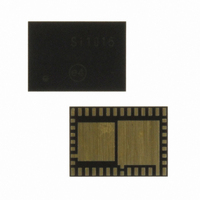SI1005-C-GM Silicon Laboratories Inc, SI1005-C-GM Datasheet - Page 248

SI1005-C-GM
Manufacturer Part Number
SI1005-C-GM
Description
IC TXRX MCU + EZRADIOPRO
Manufacturer
Silicon Laboratories Inc
Specifications of SI1005-C-GM
Package / Case
42-QFN
Frequency
240MHz ~ 960MHz
Data Rate - Maximum
256kbps
Modulation Or Protocol
FSK, GFSK, OOK
Applications
General Purpose
Power - Output
13dBm
Sensitivity
-121dBm
Voltage - Supply
0.9 V ~ 1.8 V
Current - Receiving
18.5mA
Current - Transmitting
30mA
Data Interface
PCB, Surface Mount
Memory Size
32kB Flash, 4kB RAM
Antenna Connector
PCB, Surface Mount
Number Of Receivers
1
Number Of Transmitters
1
Wireless Frequency
240 MHz to 960 MHz
Interface Type
UART, SMBus, SPI, PCA
Output Power
13 dBm
Operating Supply Voltage
0.9 V to 3.6 V
Maximum Operating Temperature
+ 85 C
Mounting Style
SMD/SMT
Maximum Supply Current
4.1 mA
Minimum Operating Temperature
- 40 C
Modulation
FSK, GFSK, OOK
Protocol Supported
C2, SMBus
Core
8051
Program Memory Type
Flash
Program Memory Size
32 KB
Data Ram Size
4352 B
Supply Current (max)
4.1 mA
Lead Free Status / RoHS Status
Lead free / RoHS Compliant
Operating Temperature
-
Lead Free Status / Rohs Status
Lead free / RoHS Compliant
Other names
336-1875-5
Available stocks
Company
Part Number
Manufacturer
Quantity
Price
Company:
Part Number:
SI1005-C-GM
Manufacturer:
Silicon Labs
Quantity:
135
- Current page: 248 of 376
- Download datasheet (3Mb)
Add R/W
Si1000/1/2/3/4/5
23.3.4. Automatic State Transition for Frequency Change
If registers 79h or 7Ah are changed in either TX or RX mode, the state machine will automatically transition
the chip back to TUNE, change the frequency, and automatically go back to either TX or RX. This feature
is useful to reduce the number of SPI commands required in a Frequency Hopping System. This in turn
reduces microcontroller activity, reducing current consumption. The exception to this is during TX FIFO
mode. If a frequency change is initiated during a TX packet, then the part will complete the current TX
packet and will only change the frequency for subsequent packets.
23.3.5. Frequency Deviation
The peak frequency deviation is configurable from ±0.625 to ±320 kHz. The Frequency Deviation (Δf) is
controlled by the Frequency Deviation Register (fd), address 71 and 72h, and is independent of the carrier
frequency setting. When enabled, regardless of the setting of the hbsel bit (high band or low band), the
resolution of the frequency deviation will remain in increments of 625 Hz. When using frequency modula-
tion the carrier frequency will deviate from the nominal center channel carrier frequency by ±Δf:
The previous equation should be used to calculate the desired frequency deviation. If desired, frequency
modulation may also be disabled in order to obtain an unmodulated carrier signal at the channel center fre-
quency; see “Modulation Type” on page 251 for further details.
248
7A
79
R/W
R/W
Frequency Hopping
Frequency Hopping
Channel Select
Description
Function/
Step Size
fd
fhch[7] fhch[6] fhch[5] fhch[4] fhch[3] fhch[2] fhch[1] fhch[0]
fhs[7]
Figure 23.4. Frequency Deviation
D7
[
: 8
f
carrier
] 0
fhs[6]
D6
f
625
f
Hz
fd
Rev. 1.0
fhs[5]
[
D5
: 8
f
] 0
f
fhs[4]
625
=
D4
peak deviation
Hz
fhs[3]
D3
Time
fhs[2]
D2
fhs[1]
D1
fhs[0]
D0
POR Def.
00h
00h
Related parts for SI1005-C-GM
Image
Part Number
Description
Manufacturer
Datasheet
Request
R
Part Number:
Description:
SMD/C°/SINGLE-ENDED OUTPUT SILICON OSCILLATOR
Manufacturer:
Silicon Laboratories Inc
Part Number:
Description:
Manufacturer:
Silicon Laboratories Inc
Datasheet:
Part Number:
Description:
N/A N/A/SI4010 AES KEYFOB DEMO WITH LCD RX
Manufacturer:
Silicon Laboratories Inc
Datasheet:
Part Number:
Description:
N/A N/A/SI4010 SIMPLIFIED KEY FOB DEMO WITH LED RX
Manufacturer:
Silicon Laboratories Inc
Datasheet:
Part Number:
Description:
N/A/-40 TO 85 OC/EZLINK MODULE; F930/4432 HIGH BAND (REV E/B1)
Manufacturer:
Silicon Laboratories Inc
Part Number:
Description:
EZLink Module; F930/4432 Low Band (rev e/B1)
Manufacturer:
Silicon Laboratories Inc
Part Number:
Description:
I°/4460 10 DBM RADIO TEST CARD 434 MHZ
Manufacturer:
Silicon Laboratories Inc
Part Number:
Description:
I°/4461 14 DBM RADIO TEST CARD 868 MHZ
Manufacturer:
Silicon Laboratories Inc
Part Number:
Description:
I°/4463 20 DBM RFSWITCH RADIO TEST CARD 460 MHZ
Manufacturer:
Silicon Laboratories Inc
Part Number:
Description:
I°/4463 20 DBM RADIO TEST CARD 868 MHZ
Manufacturer:
Silicon Laboratories Inc
Part Number:
Description:
I°/4463 27 DBM RADIO TEST CARD 868 MHZ
Manufacturer:
Silicon Laboratories Inc
Part Number:
Description:
I°/4463 SKYWORKS 30 DBM RADIO TEST CARD 915 MHZ
Manufacturer:
Silicon Laboratories Inc
Part Number:
Description:
N/A N/A/-40 TO 85 OC/4463 RFMD 30 DBM RADIO TEST CARD 915 MHZ
Manufacturer:
Silicon Laboratories Inc
Part Number:
Description:
I°/4463 20 DBM RADIO TEST CARD 169 MHZ
Manufacturer:
Silicon Laboratories Inc











